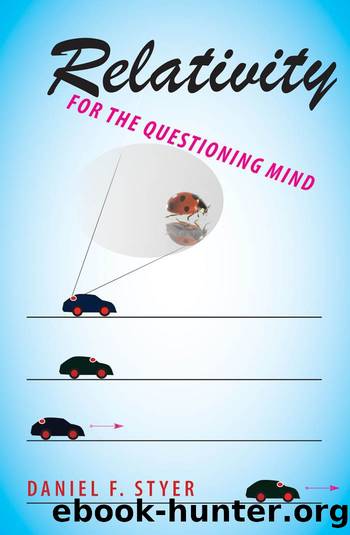Relativity for the Questioning Mind by Styer Daniel F

Author:Styer, Daniel F. [Styer, Daniel F.]
Language: eng
Format: epub
Publisher: The Johns Hopkins University Press
Published: 2011-02-16T16:00:00+00:00
an equation that you might have encountered previously.
The interconversion of energy and mass implied in E = mc 2 is one of the most surprising and unexpected results of relativity, but also one of the most beautiful and useful. The Sun works by converting mass to energy through nuclear reactions. On page 71 I listed four reasons why you should study relativity, even though it’s a small effect at everyday speeds. Here’s a fifth reason: Sometimes small effects have large consequences. Relativity is responsible for the generation of all sunlight and all starlight. We are alive today only because relativity is true. If commonsense notions of space and time were correct, then the Sun would not work, and we would never have lived.
Q: Would it be fair to summarize all we’ve learned by saying “Nothing is absolute; it’s all relative”?
A: No. This is a common misconception. For example, the author, diarist, and literary critic Anaïs Nin erroneously claimed that “the absolute became a fiction with Einstein.”
Both in relativity and in common sense some things are relative and some are not. If you look at a building from the front or from the side, you see different things. The statement “Washington, DC, is 500 miles away” is true when made in Cleveland and false when made in San Francisco. The speed of a bird relative to the ground differs from the speed of that same bird relative to a runner. There are lots of things that depend upon point of view or frame of reference (i.e., that are “relative”). Einstein’s relativity changes only which things depend on frame. In common sense, time interval doesn’t depend upon frame, but the speed of light does. In the real world of relativity it’s the other way around.
Observations from different reference frames can differ in unexpected ways, but they still represent different ways of observing the same things. If a vase falls to the floor and shatters, it shatters in all reference frames. This is an absolute, not a relative. Different frames might disagree on the details of falling, in the manner that we’ve seen in chapter 9 , “He Says, She Says.” But all frames will agree that the vase shatters.
PROBLEMS
10.1 Faster than light . I stand 10 feet from a white wall, holding a laser pointer. The pointer makes a red dot on the wall directly in front of me. Then with a quick flick of my wrist (lasting only 0.1 second) I twist the laser pointer by 45°, and the red dot moves 10 feet in 0.1 second. I repeat the experiment standing 20 feet from a white wall, and the red dot moves 20 feet in 0.1 second. Finally, I repeat the experiment standing 186 000 miles from a white wall, and the red dot moves 186 000 miles in 0.1 second. In other words, the red dot moves 10 times faster than light speed. Why doesn’t this motion violate the speed limit derived in this chapter?
10.2 Paradox?
a. The year is 1492, and you are discussing with a friend the radical idea that the Earth is round.
Download
This site does not store any files on its server. We only index and link to content provided by other sites. Please contact the content providers to delete copyright contents if any and email us, we'll remove relevant links or contents immediately.
| Biomathematics | Differential Equations |
| Game Theory | Graph Theory |
| Linear Programming | Probability & Statistics |
| Statistics | Stochastic Modeling |
| Vector Analysis |
Weapons of Math Destruction by Cathy O'Neil(5037)
Factfulness: Ten Reasons We're Wrong About the World – and Why Things Are Better Than You Think by Hans Rosling(4021)
Factfulness_Ten Reasons We're Wrong About the World_and Why Things Are Better Than You Think by Hans Rosling(2754)
Descartes' Error by Antonio Damasio(2731)
A Mind For Numbers: How to Excel at Math and Science (Even If You Flunked Algebra) by Barbara Oakley(2691)
TCP IP by Todd Lammle(2639)
Applied Predictive Modeling by Max Kuhn & Kjell Johnson(2478)
Fooled by Randomness: The Hidden Role of Chance in Life and in the Markets by Nassim Nicholas Taleb(2413)
The Book of Numbers by Peter Bentley(2404)
The Tyranny of Metrics by Jerry Z. Muller(2401)
The Great Unknown by Marcus du Sautoy(2186)
Once Upon an Algorithm by Martin Erwig(2149)
Easy Algebra Step-by-Step by Sandra Luna McCune(2117)
Practical Guide To Principal Component Methods in R (Multivariate Analysis Book 2) by Alboukadel Kassambara(2092)
Lady Luck by Kristen Ashley(2073)
Police Exams Prep 2018-2019 by Kaplan Test Prep(2032)
Linear Time-Invariant Systems, Behaviors and Modules by Ulrich Oberst & Martin Scheicher & Ingrid Scheicher(1983)
All Things Reconsidered by Bill Thompson III(1960)
Secrets of Creation, Volume 1: The Mystery of the Prime Numbers by Watkins Matthew(1864)
